In order to effectively care for toddlers and small children at the beach—or any location with strong UV rays—it is critical to know sun-safe preventive care routines. While skin cancer is the most commonly diagnosed cancer in the United States, most cases are preventable if skin cancer risk factors are addressed, including inadequate sun protection.
According to pediatric dermatologist Dr. Kalyani Marathe, a clinician at Children’s National Health System in Washington, D.C., sunburns at an early age are associated with an increased risk of melanoma. Moreover, The Centers for Disease Control and Prevention note that UV rays can burn and damage skin in as little as 15 minutes. The CDC further highlights the inherent dangers of tanning, asserting that any change in the color of a child’s skin after time outside—whether sunburn or suntan—indicates damage from UV rays.
1. Select the correct sunscreen
Marathe advises choosing an SPF of at least 30, with ingredients that contain at least 10 to 15 percent zinc oxide / more than 5 percent titanium dioxide. Sunscreens with active ingredients of zinc and titanium physically block broad-spectrum UVA and UVB rays, and mineral-based sunscreens decrease the risk of irritation on young skin. Marathe notes that while aerosol sunscreen sprays are popular due to convenience, they are notorious for missing spots.
2. Choose sunscreens for sensitive skin
Sunscreens designed for sensitive skin are often made with fragrance-free formulas. While actual allergies to sunscreen are rare, testing a potential sunscreen—by applying it to the inner part of a child’s arm twice a day for a week—can can rule out any allergens.
3. Investigate sunscreens for the face
Areas often missed are faces, ears, and the back of the neck, so the waxier texture of a stick formula is a prudent and effective choice.
4. Apply sunscreen often
Parents should make a conscious effort to remember reapplying SPF at least every two hours, or every hour if children are sweating often or swimming. Because 70 percent of UV radiation sneaks through clouds, parents should still stick to this schedule on an overcast day. Maratha states, “Most people learn that the hard way after getting burned.”
5. Look beyond SPF
Parents should consider purchasing a long-sleeve rash guard, often an easier way to protect small children’s skin from the sun—although SPF should always be used on uncovered areas. Toddlers should also wear hats and sunglasses, or at least use a sun protective umbrella or tent that can provide up to SPF 50 sun protection.
Interested in pediatric dermatology and skin care? Join our Master’s of Pediatric Dermatology: a one-day symposium held on Thursday, February 7, 2019 at the Loews Miami Beach Hotel. Chaired by Dr. Lawrence Schachner, Director of Pediatric Dermatology at the University of Miami Health System, this event will explore the latest treatment approaches, protocols, and tools needed to support children with dermatologic conditions.
SOURCES
https://www.cdc.gov/cancer/skin/basic_info/children.htm
https://www.today.com/health/best-sunscreen-kids-how-keep-toddlers-safe-sun-t130735
















